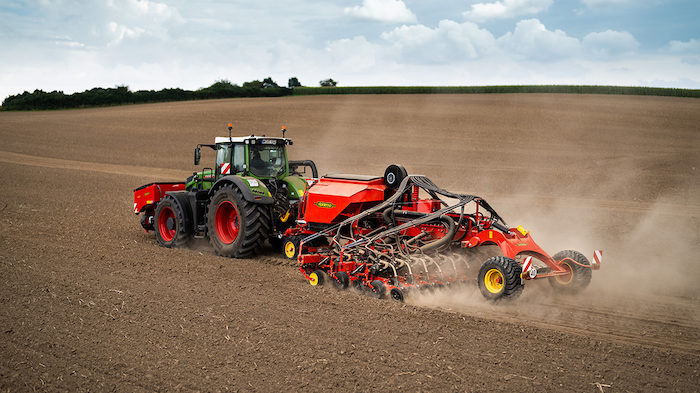Swedish implement manufacturer Vaderstad’s Proceed precision drill can be used to establish cereal crops, canola, sugar/fodder beet, peas, maize and even large seed crops such as sunflowers. After 3 years of development, the company says it’s a game changer. But you won’t be able to get your hands on it in North America until after this year’s crops are harvested
The company reports that trials in wheat have shown that seed rates can be halved, without any reduction in yield. Over the 3-year development period, trials were conducted in Sweden, the UK, France and Germany.
Post-seeding trials in winter wheat, at a seed rate of 150 seeds/m2, showed an increase of 102% in plant biomass, 72% in root biomass and 62% more shoots per plant, compared to a modern seed drill.
Flagged as a one-stop solution for all crops and conditions, the new machine is said to be equally at home on plowed land, minimum-tillage situations, planting into cover crops or direct drilling. Planting units are arranged in two banks, allowing row spacing of 22.5 or 25cm in cereals. Working in multiples of these numbers, the machine can be set to drill at 45 or 50cm for beet crops or canola, or pushed out to 75cm for maize, cotton and sunflowers.
Ahead of each row unit, the press wheels are said to be dual-purpose, serving to carry the weight of the machine and also creating soil consolidation for optimal planting conditions. Seed is delivered from a central hopper with a 3,000-litre capacity, with the option of delivering fertilizer during planting via the company’s FH2000 front-mounted hopper system.
Seed metering from the central hopper is by way of a modified version of Vaderstad’s PowerShot singulation system. Leaving the short seed tube, each seed is received by a stop wheel that ensures optimal seed-to-soil contact at selected depth across the full working width of the drill.
Each row is electronically- driven and controlled using the I-pad-based, E-Control System. This offers functions such as row by row shut off, variable rate application, dynamic tramlining, individual calibration, alongside realtime monitoring and control.







Post a comment
Report Abusive Comment